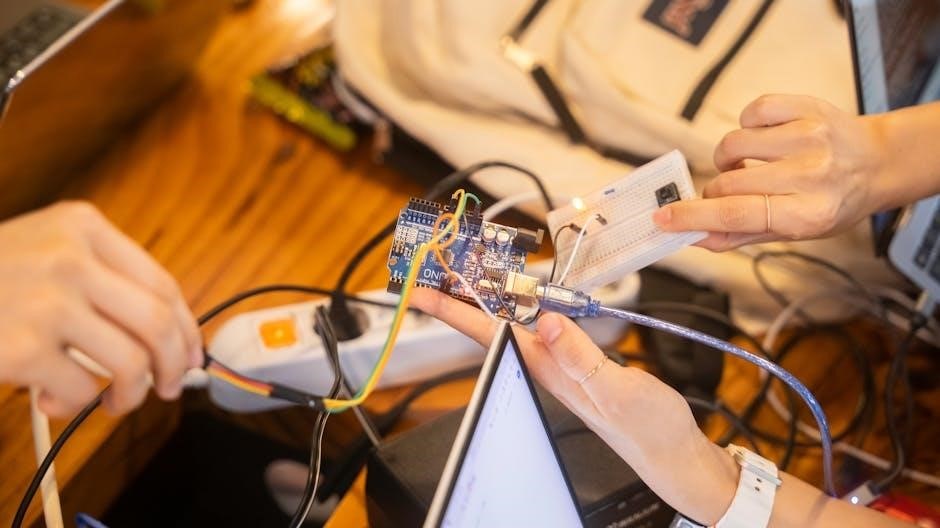1.1 Overview of the Honeywell TH5220D1003 Thermostat
The Honeywell TH5220D1003 is a programmable touchscreen thermostat designed for efficient temperature control in residential settings, offering advanced features like auto changeover and energy-saving modes.
1.2 Importance of the Programming Manual
This manual provides essential guidance for installing, operating, and programming the thermostat, ensuring users can optimize its features for comfort and energy efficiency.
The Honeywell TH5220D1003 is a programmable thermostat designed for efficient temperature control in residential environments. Part of the FocusPRO series, it is compatible with systems requiring up to 2 stages of heating and cooling, including heat pumps. This thermostat features an intuitive touchscreen interface, making it user-friendly for setting temperature preferences and scheduling. It supports various operating modes, such as 5-2, 5-1-1, or manual changeover, allowing users to tailor settings to their lifestyle. The device is energy-efficient and includes advanced features like auto changeover, which automatically switches between heating and cooling based on temperature demand. The manual provides detailed instructions for installation, wiring, and programming, ensuring optimal performance. With its robust design and Honeywell’s reputation for reliability, the TH5220D1003 is a versatile solution for modern heating and cooling needs.
The Honeywell TH5220D1003 Programming Manual is a critical resource for users to fully utilize the thermostat’s capabilities. It provides detailed instructions for installation, wiring, and programming, ensuring proper setup and operation. The manual explains how to navigate the touchscreen interface, configure temperature settings, and customize schedules to suit individual preferences. Additionally, it covers advanced features such as auto changeover and energy-saving modes, helping users optimize energy efficiency. Troubleshooting tips and maintenance guidelines are also included to address common issues and extend the product’s lifespan. By following the manual, users can ensure their thermostat operates efficiently, providing consistent comfort while reducing energy consumption. This comprehensive guide is essential for both new and experienced users to maximize the thermostat’s performance and functionality.

Installation and Wiring
This section provides a pre-installation checklist, wiring diagram selection, and safety precautions to ensure proper setup and functionality of the Honeywell TH5220D1003 thermostat.
Before installing the Honeywell TH5220D1003, ensure you have the correct wiring diagram for your HVAC system. Verify compatibility with your heating and cooling setup, whether it’s a heat pump, gas, or electric system. Check the voltage requirements and ensure the power is off during installation. Gather necessary tools like screwdrivers and wire strippers. Review the thermostat’s terminal labels (R, W, Y, etc.) to match your system’s wiring. If replacing an old thermostat, note the existing wire connections. Ensure the wall surface is level and clean. Familiarize yourself with the installation manual to avoid errors. Proper preparation ensures a smooth and safe installation process. Selecting the correct wiring diagram is crucial for proper installation. The Honeywell TH5220D1003 supports various HVAC systems, including 2 heat/2 cool setups and heat pumps. Refer to the manual to identify the appropriate wiring diagram for your specific system. Match the terminal labels (R, W, Y, etc.) on the thermostat with your system’s wiring. For heat pumps, ensure the changeover valve is configured correctly. Use the provided wiring guide to avoid mismatches. Proper wiring ensures safe and efficient operation. If unsure, consult a licensed technician. Always follow the manufacturer’s instructions for accurate connections. Incorrect wiring can lead to system malfunctions or safety hazards. Double-check all connections before powering up the system. This step is critical for optimal performance and longevity of the thermostat. Ensure the system is powered off at the circuit breaker before starting installation to prevent electrical shocks or injuries. Verify the power is off using a voltage tester. Wear protective gloves and eyewear to safeguard against potential hazards. Avoid damaging existing wiring by carefully labeling and organizing connections. Follow all local electrical codes and regulations. Do not attempt installation if unsure about any step. If the system involves gas or high-voltage components, consider hiring a licensed professional. Keep the work area clean and well-lit to minimize accidents. Properly dispose of old thermostat materials and packaging. Refer to the manual for specific safety guidelines tailored to the Honeywell TH5220D1003. Adhering to these precautions ensures a safe and successful installation process. Always prioritize safety to protect yourself and the equipment. The Honeywell TH5220D1003 operates with a user-friendly interface, allowing easy navigation through menus. Basic functions include adjusting temperature, switching modes, and viewing schedules. The touchscreen display simplifies daily operation, ensuring comfort and efficiency. The Honeywell TH5220D1003 features a user-friendly interface with a touchscreen display, making it easy to navigate and adjust settings. Users can interact using the ‘s’ and ‘FAN’ buttons to scroll through menus and options. Basic operations include setting the desired temperature, switching between heating and cooling modes, and viewing the current schedule. The thermostat also provides clear visual feedback, displaying the current temperature and set points. For simplicity, many settings can be adjusted without entering programming mode, allowing for quick changes. The interface is intuitive, ensuring that even novice users can operate the thermostat effectively. Additionally, the display offers insights into system status and energy usage, helping users optimize their comfort and energy efficiency. This straightforward design makes daily operation seamless and stress-free. The Honeywell TH5220D1003 thermostat features a touchscreen interface designed for ease of use. The display provides clear visual feedback, showing current temperature, set points, and system status. Key buttons, such as ‘s’ and ‘FAN,’ simplify navigation and adjustments. The interface organizes settings into intuitive menus, allowing users to access programming, system mode, and energy-saving features effortlessly. Icons and text prompts guide users through operations, making it easy to understand and modify settings. The touchscreen responds smoothly to taps, ensuring precise control over temperature and scheduling. Additionally, the interface includes indicators for battery status and system operation, keeping users informed. This intuitive design ensures that even those unfamiliar with programmable thermostats can navigate and customize settings with confidence. The user-friendly layout enhances overall functionality, making the thermostat both practical and efficient for daily use. Programming the Honeywell TH5220D1003 involves entering setup mode by pressing and holding the ‘s’ and ‘FAN’ buttons, then configuring settings like temperature, scheduling, and system mode. To enter programming mode on the Honeywell TH5220D1003, press and hold the “s” and “FAN” buttons simultaneously until the display changes to setup mode. This allows access to advanced settings. Use the “s” and “t” buttons to navigate and adjust parameters. The manual outlines 16 steps for configuring options like setup codes and sensor selection. Ensure the thermostat is properly configured for heat pumps or other systems. Follow the on-screen prompts to customize settings. Battery-powered models may require ensuring the device is powered on. Properly configure the changeover valve for heat or cool modes. This mode enables setting temperature readouts and system preferences. Always refer to the manual for detailed instructions. Proper configuration ensures optimal performance and energy efficiency. After entering programming mode, configure function program parameters to customize thermostat operation. Use the “s” and “t” buttons to navigate and adjust settings like temperature readout format (Celsius or Fahrenheit) and system preferences. Set the operating mode, such as heat, cool, or auto, and configure the changeover valve for heat pumps. Define temperature differential and cycle rate for optimal performance. Ensure proper system type selection (e.g., 1 heat/1 cool or 2 heat/2 cool). Adjust fan operation settings and humidity control if applicable. Refer to the manual for detailed step-by-step instructions. Proper configuration ensures the thermostat operates efficiently and meets specific system requirements. Troubleshooting tips are provided for common issues during setup. Always verify settings align with your HVAC system’s capabilities for reliable performance. Configure temperature settings to match your comfort preferences and energy-saving goals. Set the temperature readout format (Celsius or Fahrenheit) and define temperature set points for heating and cooling. Adjust the day and night temperature differential to balance comfort and energy use. For heat pumps, configure the changeover temperature to ensure smooth transitions between heating and cooling modes. Define the minimum and maximum temperature limits to prevent extreme settings. Use the “s” and “t” buttons to navigate and adjust these parameters. Ensure settings align with your HVAC system’s capabilities. Proper configuration enhances efficiency and comfort. Refer to the manual for detailed instructions on optimizing temperature settings for your specific needs. The Honeywell TH5220D1003 offers flexible scheduling options to tailor temperature settings to your lifestyle. Choose from 5-2, 5-1-1, or other configurations to customize your weekly schedule. In 5-2 mode, set one schedule for weekdays and another for weekends. For 5-1-1, define separate schedules for Saturday and Sunday. Access scheduling options by entering programming mode and selecting the desired schedule type. Use the “s” and “t” buttons to adjust temperature set points for each time period. This feature allows you to optimize energy use while maintaining comfort. Properly configuring schedules ensures your system operates efficiently. Refer to the manual for step-by-step guidance on setting up and managing your preferred schedule. This feature is key to maximizing the thermostat’s energy-saving capabilities. The Honeywell TH5220D1003 offers advanced features like auto changeover between heat and cool modes, enhancing efficiency and comfort in various climates. The Honeywell TH5220D1003 features an auto changeover function, allowing seamless transitions between heating and cooling modes based on temperature settings. This feature is ideal for climates requiring both heating and cooling throughout the year. When enabled, the thermostat automatically switches between heat and cool modes to maintain the desired temperature, optimizing comfort and energy efficiency. Users can configure this setting during the initial setup or adjust it later through the programming menu. The auto changeover function eliminates the need for manual switching, ensuring consistent indoor comfort without user intervention. It is particularly beneficial for heat pump systems, where efficient operation depends on smooth transitions between heating and cooling cycles. Proper configuration ensures optimal performance and energy savings. The Honeywell TH5220D1003 offers various energy-saving modes and settings to help reduce energy consumption. These include programmable temperature settings, which allow users to customize their comfort levels throughout the day. The thermostat also features an energy-saving mode that adjusts heating and cooling usage based on the home’s occupancy schedule. Additionally, it supports features like smart recovery, which learns the system’s operation to pre-heat or pre-cool the home efficiently. Regular cleaning of the thermostat and checking battery levels ensures optimal performance. Refer to the manual for troubleshooting common issues like display problems or connectivity loss. To keep your Honeywell TH5220D1003 thermostat functioning optimally, perform regular maintenance. Start by cleaning the display and exterior with a soft, dry cloth to prevent dust buildup. Check the batteries periodically and replace them when the low-battery indicator appears. Ensure the thermostat is level on the wall to maintain accurate temperature readings. Additionally, review and update your programmed settings seasonally to reflect changing temperature needs. For systems with air filters, replace them as recommended to improve efficiency and airflow. Lastly, verify that all wiring connections are secure and consult the manual if any issues arise during maintenance. If the display does not turn on, check the batteries and ensure they are installed correctly. For inaccurate temperature readings, recalibrate the thermostat by pressing and holding the “S” and “FAN” buttons. If the system does not respond to temperature changes, verify wiring connections and consult the wiring diagram. Programming issues may occur if the thermostat is not properly configured; restart the device and re-enter settings. For connectivity problems with smart home systems, ensure the thermostat is paired correctly and check for firmware updates. Refer to the troubleshooting section in the manual for detailed solutions and reset procedures if necessary. Regular maintenance and updates can prevent most issues, ensuring reliable performance. Replace the batteries annually or when the display indicates low battery levels. Use alkaline batteries (AA or AAA) for optimal performance. To access the battery compartment, remove the thermostat from the wall plate by gently pulling it forward. Open the compartment and replace the batteries, ensuring correct polarity. After replacement, reattach the thermostat and check for proper functionality. Dispose of old batteries responsibly, following local recycling guidelines. If the thermostat malfunctions after battery replacement, reset it by pressing and holding the “S” and “FAN” buttons for 10 seconds. Refer to the manual for detailed instructions and troubleshooting tips to ensure smooth operation. Regular battery maintenance ensures uninterrupted temperature control and extends the thermostat’s lifespan. Visit Honeywell’s official website for detailed manuals, troubleshooting guides, and customer support. Additional resources are available online for advanced setup and programming assistance. Honeywell provides comprehensive customer support and detailed documentation for the TH5220D1003 thermostat. Users can access the official Honeywell website for downloadable manuals, troubleshooting guides, and installation instructions. The website also offers FAQs, warranty information, and contact details for technical assistance. Additionally, Honeywell’s customer service team is available via phone or email to address specific inquiries. The documentation includes step-by-step instructions for programming, maintenance, and troubleshooting, ensuring users can resolve issues independently. Honeywell also provides resources for recycling and proper disposal of old thermostats. For advanced guidance, users can refer to the Honeywell TH5220D1003 Manual, which covers function program settings, scheduling options, and energy-saving features. This support ensures optimal performance and user satisfaction. For further assistance with the Honeywell TH5220D1003, users can explore online resources such as the official Honeywell website, forums, and YouTube tutorials. These platforms provide detailed guides, video demonstrations, and troubleshooting tips. Additionally, PDF manuals and user-generated content offer alternative perspectives for complex setups. Online forums allow users to share experiences and solutions, addressing specific challenges. Honeywell’s official documentation, including installation and programming manuals, is readily available for download. These resources ensure users can resolve issues and maximize their thermostat’s functionality. By leveraging these online tools, users can gain deeper insights and troubleshooting expertise, enhancing their overall experience with the Honeywell TH5220D1003. The Honeywell TH5220D1003 programming manual serves as a comprehensive guide to unlocking the full potential of your thermostat. By following the instructions outlined, users can efficiently program and maintain their device, ensuring optimal performance and energy savings. The manual’s detailed sections on installation, programming, and troubleshooting provide a clear roadmap for both novice and experienced users. With its user-friendly interface and advanced features, the Honeywell TH5220D1003 is designed to enhance comfort while reducing energy consumption. By leveraging the insights and guidelines provided, users can confidently manage their home’s climate with precision and ease. This manual is an invaluable resource for anyone seeking to maximize the benefits of their Honeywell thermostat.2.1 Pre-Installation Checklist
2.2 Wiring Diagram Selection
2;3 Safety Precautions During Installation

Operating the Thermostat
3.1 Basic Operation and Navigation
3.2 Understanding the User Interface

Programming the Thermostat
4.1 Entering Programming Mode
4.2 Setting Up Function Program Parameters


4.3 Configuring Temperature Settings
4.4 Scheduling Options (5-2, 5-1-1, etc.)

Advanced Features
5.1 Auto Changeover (Heat/Cool)
5.2 Energy-Saving Modes and Settings

By utilizing these settings, users can minimize energy waste and lower their utility bills. The programmable modes ensure that the system operates only when needed, enhancing overall efficiency. Proper configuration of these settings is essential to maximize energy savings while maintaining comfort.
Maintenance and Troubleshooting
6.1 Routine Maintenance Tips
6.2 Common Issues and Solutions
6.3 Battery Replacement Guidelines

Resources and References
7.1 Honeywell Customer Support and Documentation
7.2 Online Resources for Additional Guidance
